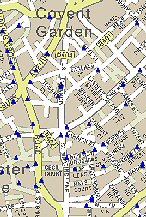


   |
Useful TETRA links: Find where masts are |
|||
|
Use Sitefinder to home in on where masts are reported to be. Note that TETRA will often be co-located with existing mmO2 masts, and may not imediately be labelled TETRA. The database is supposedly renewed every 3 months. (Repeater masts are not shown at all.) Sitefinder is not known for its great accuracy: heights, powers, even the type of a transmitter, can vary from time to time, even though nothing has changed. We suspect that it must be the weight of antennae causing subsidence, that makes masts actually get shorter on successive updates to Sitefinder! Maybe this is a public health and safety issue!
May 2007: Phone mast locations kept from public. Ofcom is facing a Freedom of Information action to get it to disclose nationwide information in the site on request. As a result, it says: ‘The mobile network operators have decided not to provide any further information to Ofcom about sites they build or change.’ Pique? Ofcom is proving ineffectual again. Why does it matter? See below. It might be appallingly inaccurate, but as a means for avoidance it can be invaluable. Example: October 2004. Was it an error? TETRA was removed from the Sitefinder website/database for a month. We wrote and complained and were reassured that it was just an update error. By Ofcom professional webmasters? By O2 data technicians in a hi-tech company? With no backup or roll-back facilities? Well ... maybe. November 3, TETRA was restored. So how else do you find TETRA? Anyone with a scanner can find a transmitter operating between 380-400MHz, and anyone with anything more sophisticated can pinpoint them. How else do you find TETRA? Ask anyone who has become electro-sensitive to them. They’ll tell you! Why this is important. Knowing where TETRA is can make life bearable for some people who are sensitive: who cannot sleep, or who have constant headaches etc. Finding TETRA and living somewhere clear of it can mean restoration to some normality of life. Being unable to locate TETRA can result in moving house at great personal expense, only to find it somewhere else. According to the Telecommunications Masts (Registration) Bill (2004), Paragraph 30:
Having been told by mmO2 that TETRA mast details will not be submitted to Sitefinder ‘until the network is complete’, as directed by the Home Office, we found (02 July 2004) that the updates had mostly been done, six months and more after installation. TETRA was added to Sitefinder at the start of the Airwave project, and earlier installations were registered. But what ‘completion’ means at any time will be up to the Home Office or mmO2, and if because of the data failings of Airwave this means twice as many masts and developments until it works, this could be years away. So much for open government and freedom of information. Please note: O2 Airwave appear to be acting secretively, despite the very obvious appearance of TETRA masts, labelled ‘O2 Airwave’. Therefore they do not submit information to Sitefinder very promptly. So your local masts may not appear on Sitefinder some months and more after construction and operation. Nor do O2 Airwave like their contractors talking to observers (residents etc.!), especially not if it involves admitting it is TETRA. Why TETRA masts are secret and a matter of national securityWhere are TETRA masts? Is this a matter of national security? Try asking your police authority. Here are 8 examples of how location confidentiality is a matter of national security:
Does that make them vulnerable? You bet. Funny how we never used to notice the old police VHF/UHF aerials... |
 Sitefinder shows all masts, eventually. TETRA will all be on there one day. And as you can see, some places have rather a lot of microwave base stations, marked by the blue triangles.
Sitefinder shows all masts, eventually. TETRA will all be on there one day. And as you can see, some places have rather a lot of microwave base stations, marked by the blue triangles.
|
||
Home | |||